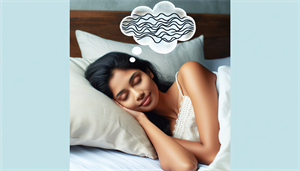In the silent hours of the night, millions of people around the world grapple with two unusual yet pervasive sleep disorders: sleep apnea and sleep paralysis. Despite their distinct manifestations, these conditions may be intertwined in ways we are just beginning to understand.
They not only disrupt our sleep but can also profoundly impact our daily lives and overall well-being. A journey through the realm of sleep science awaits us, ready to unravel the mysteries of these sleep disturbances and guide us towards a night of peaceful slumber.
Key Takeaways
-
Sleep apnea and paralysis are complex conditions with a high rate of comorbidity, and treatments for apnea may reduce paralysis episodes, highlighting their interconnected nature.
-
Symptoms of sleep apnea include snoring, gasping for air, and excessive daytime sleepiness, and sleep paralysis presents as temporary immobility and hallucinations during REM sleep.
-
Effective management strategies for improving sleep health and treating both conditions involve lifestyle changes, good sleep hygiene, and medical interventions such as CPAP therapy.
Exploring the Intersection of Sleep Apnea and Sleep Paralysis
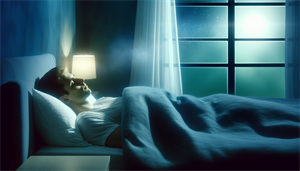
Sleep apnea and sleep paralysis are not just mere interruptions in our sleep; they are complex conditions that can potentially harm our health and quality of life. Sleep apnea, characterized by interrupted breathing during sleep, can lead to chronic sleep deprivation and other health issues. On the other hand, sleep paralysis, defined by temporary immobility and distressing hallucinations during sleep, can evoke feelings of intense fear and helplessness. What if these two seemingly distinct sleep disorders were somehow connected? A growing body of research suggests that this might be the case, indicating a possible link between apnea and sleep paralysis as a combined sleep disorder.
Symptoms of sleep apnea can exacerbate sleep paralysis episodes, suggesting a possible link between these two sleep disorders. This connection is supported by a higher prevalence of sleep paralysis among those with sleep apnea compared with the general population. Moreover, treatments for sleep apnea have shown potential in reducing sleep paralysis episodes, emphasizing the interconnectedness of these conditions. Therefore, gaining a deeper understanding of these sleep disorders and how they interact is of utmost importance.
The Nature of Sleep Apnea
Obstructive sleep apnea, the predominant form of sleep apnea, is characterized by intermittent closure of the airway during sleep. This can lead to episodes of sleep paralysis, making individuals feel helpless and terrified. Conditions that obstruct airflow through the upper airways during sleep, such as the backward movement of the tongue or excessive weight and obesity, are the main factors contributing to sleep apnea. Identifying these factors is key for precise diagnosis and successful treatment.
Diagnosis of sleep apnea involves evaluation of symptoms and sleep history by a healthcare provider, who may also conduct a sleep apnea test known as a polysomnogram (PSG). Untreated sleep apnea can result in chronic sleep deprivation and various mental and physical health complications. Hence, early recognition of sleep apnea symptoms and seeking timely medical intervention is vital.
Understanding Sleep Paralysis Episodes
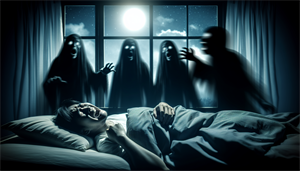
Sleep paralysis is a temporary condition characterized by the inability to move or speak during REM sleep, often accompanied by hallucinations and distressing emotions. Imagine waking up in the middle of the night, unable to move or speak, and experiencing intense hallucinations. This is the reality for individuals who experience sleep paralysis. The symptoms can be distressing, including a feeling of being suffocated, as well as intense visual and sensory hallucinations that can evoke sensations of powerlessness and anxiety, making the sleep paralysis feel terrifying.
The occurrence of sleep paralysis, including recurrent isolated sleep paralysis, may be associated with vivid nightmares or lucid dreaming. The perception of episodes can vary significantly, influenced by personality and cultural context, with some episodes involving distinct hallucinations. While there are no established therapies to completely eliminate sleep paralysis episodes, individuals are advised to focus on enhancing their sleep hygiene and addressing any associated sleep disorders, such as narcolepsy.
A comprehensive understanding of sleep paralysis is necessary for its effective management and for reducing its potential impact on overall sleep health.
How Apnea and Sleep Paralysis May Feed Off Each Other
Inadequate sleep quality and disruptions in sleep can be contributing factors to the occurrence of both sleep apnea and sleep paralysis. The interrupted breathing pattern caused by sleep apnea is considered to be a contributing factor to the occurrence of sleep paralysis. This suggests that the two conditions may feed off each other, each exacerbating the other’s symptoms, leading to a vicious cycle of poor sleep and recurrent episodes of sleep disturbances.
Interestingly, lifestyle changes such as weight loss have the potential to lessen the severity of sleep apnea symptoms and completely resolve sleep paralysis. This highlights the role of a healthy lifestyle and good sleep hygiene in managing these sleep disorders. Consequently, comprehending the intricate relationship between sleep apnea and sleep paralysis is essential to formulate holistic strategies to mitigate the effects of these conditions.
Identifying Symptoms: When to Be Concerned
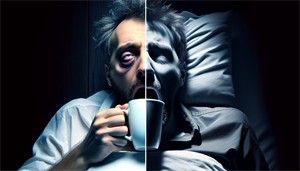
Recognizing the symptoms of sleep disorders is the first step towards effective management. Both sleep apnea and sleep paralysis may exhibit symptoms such as difficulty breathing, chest discomfort, and a sensation of impending doom. These shared symptoms underscore the potential connection between these two conditions. However, each condition also manifests unique symptoms, pivotal for their precise diagnosis.
An individual experiencing sleep apnea may exhibit symptoms such as loud snoring accompanied by gasping, choking, or pauses in breathing. On the other hand, episodes of sleep paralysis are often characterized by physical symptoms such as limb paralysis, speech difficulty, feelings of suffocation, and possible hallucinations. Psychological symptoms may include intense fear and panic. Identification of these symptoms can expedite diagnosis and treatment, thereby enhancing sleep quality and overall well-being.
Recognizing Sleep Apnea Signs
The principal indicators of sleep apnea comprise:
-
Snoring
-
Gasping for air during sleep
-
Excessive daytime sleepiness
-
Non-restorative sleep despite an adequate total sleep duration of 8 to 10 hours per night
-
Morning headaches
These symptoms highlight the disruptive impact of sleep apnea on sleep quality and daily functioning.
Interestingly, the symptoms of central sleep apnea and obstructive sleep apnea can vary. While both conditions can result in excessive daytime sleepiness and snoring, central sleep apnea is frequently linked to severe fatigue, daytime drowsiness, and difficulty concentrating.
Conversely, obstructive sleep apnea is notably defined by loud snoring. Identifying these specific symptoms can enable precise diagnosis and successful treatment, thereby lessening the impact of these conditions on daily life.
Hallmarks of Sleep Paralysis
Sleep paralysis is characterized by a sensation of consciousness but an inability to move, breathing difficulties, tightness in the chest, and a feeling of imminent danger. These symptoms can be distressing and can disrupt sleep quality. Individuals often encounter hypnogogic and hypnopompic hallucinations during sleep paralysis, such as perceiving space aliens and shadow-people in their bedroom. These hallucinations can further exacerbate the distress associated with sleep paralysis.
The sensations of panic or dread during sleep paralysis can be attributed to distressing emotions, a sense of helplessness, and the experience of terror and distress. Grasping these symptoms is vital for managing sleep paralysis and reducing its impact on overall sleep health. An episode of sleep paralysis can generally last from a few seconds to 1 or 2 minutes, further emphasizing the transient yet deeply distressing nature of this condition.
Strategies to Improve Sleep Health
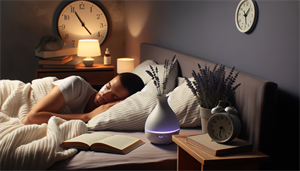
Improving sleep health is a cornerstone in the management of sleep disorders. A combination of lifestyle modifications, good sleep hygiene, and medical interventions can help manage sleep apnea and sleep paralysis symptoms, and improve overall sleep quality. Let’s examine various strategies that can enhance sleep health.
Sleep hygiene encompasses a collection of practices and habits that foster optimal sleep quality and duration, proving to be crucial in the management of conditions such as sleep apnea and sleep paralysis. Adjusting lifestyle habits, such as diet and exercise, can also contribute to better sleep health. Maintaining a consistent sleep schedule is crucial for promoting sleep health, as it stabilizes mental and physical health, boosts performance, and maintains the body’s internal clock, which may in turn alleviate symptoms of sleep apnea and sleep paralysis.
Furthermore, optimizing the bedroom environment through the control of light and noise levels, temperature, and comfort can contribute to enhanced sleep quality.
Prioritizing Good Sleep Hygiene
Good sleep hygiene is fundamental to maintaining optimal sleep quality and managing sleep disorders. It involves establishing a consistent routine, adopting healthy habits, optimizing the sleeping environment, and implementing strategies such as maintaining a regular sleep schedule, investing in a suitable mattress, managing light and noise, controlling room temperature, engaging in regular physical activity, moderating caffeine and alcohol consumption, avoiding heavy meals before bedtime, minimizing screen time, and ensuring a comfortable sleep environment.
Moreover, incorporating calming activities into a bedtime routine can enhance sleep hygiene. Some examples of calming activities to consider include:
-
Establishing a consistent bedtime
-
Limiting screen time
-
Having a light snack or herbal tea
-
Taking a warm bath
-
Listening to soothing music
-
Participating in relaxation techniques like stretching and deep breathing
Engaging in these activities can help in falling asleep, ultimately contributing to a better night’s sleep.
Therefore, giving priority to good sleep hygiene is crucial for long-term management of sleep disorders.
Adjusting Lifestyle Habits
Lifestyle habits have a significant impact on sleep health. Consuming alcohol relaxes the muscles in the throat, causing obstruction of the airways and difficulty in breathing, which can exacerbate symptoms of sleep apnea. Therefore, it’s advisable to abstain from alcohol consumption at least 3 to 4 hours before the usual bedtime.
Similarly, caffeine intake should be restricted to a minimum of 6 hours before bedtime, as consuming caffeine too close to this time can interfere with sleep. The habit of smoking can also adversely impact sleep quality. Nicotine has the potential to cause inflammation in the airways, which can affect sleep. It is therefore advisable to refrain from smoking for several hours before bedtime to minimize its impact.
Reducing the consumption of caffeine, alcohol, and tobacco can bolster the physical, mental, and emotional health of the body, which is essential for managing sleep apnea and sleep paralysis, thereby improving sleep quality and reducing sleep disturbances.
Tailoring Diet and Exercise
Diet and exercise are key components of a healthy lifestyle and can significantly contribute to better sleep health. Sleep apnea and sleep paralysis can be affected by various factors, including:
-
Alcohol
-
Caffeine
-
Smoking
-
Poor sleep hygiene
Overeating and weight gain can also elevate the risk of sleep apnea. Furthermore, a diet rich in refined carbohydrates may heighten the probability of experiencing insomnia.
Adopting a balanced diet can help manage sleep disorders. Focus on the consumption of:
-
Fruits and vegetables
-
Foods abundant in melatonin
-
Green tea
-
Omega-3 fatty acids
-
Tryptophan
-
Low-fat dairy
-
Whole grains
Regular physical activity can also enhance overall physical well-being and assist in regulating sleep patterns by maintaining body temperature and cardiovascular health.
Exercises that may be effective for the management of sleep apnea comprise facial muscle exercises, breathing exercises, mouth and throat exercises, and jaw stretches.
Medical Interventions and Therapies
While lifestyle modifications and good sleep hygiene form the bedrock of managing sleep disorders, medical interventions and therapies play an equally crucial role in treating sleep apnea and sleep paralysis. Let’s examine a variety of medical interventions and therapies that can assist in treating these conditions and enhancing sleep quality.
Commonly used medical interventions for sleep apnea comprise:
-
Supplemental oxygen
-
CPAP
-
BPAP
-
Adaptive servo-ventilation (ASV)
These therapies can significantly alleviate symptoms and improve sleep quality. On the other hand, mental health support, including cognitive-behavioral therapy, can help address the underlying psychological factors contributing to sleep disorders.
Utilizing Sleep Apnea Treatment

Among the various treatments for sleep apnea, Continuous Positive Airway Pressure (CPAP) therapy stands out due to its effectiveness. CPAP therapy is a medical intervention that uses a machine to administer pressurized air through a mask to an individual who is breathing naturally. The purpose of the pressurized air is to uphold open upper airway passages, thereby averting snoring and disruptions in breathing during sleep, which are indicative of sleep apnea.
CPAP therapy can enhance the overall quality of sleep and alleviate symptoms of sleep paralysis by maintaining a consistent airflow, thereby preventing the disrupted breathing patterns that could lead to episodes of sleep paralysis. Although CPAP therapy is known for its efficacy in treating sleep apnea, it can lead to side effects including:
-
Skin marks
-
Dry nose and mouth
-
Bloating from swallowing air
-
Dry eyes
-
Headaches
-
Shortness of breath
-
Discomfort
-
Skin irritation
-
Claustrophobia
-
Infections
-
Nasal congestion
Comprehending these potential side effects is key to managing the treatment effectively.
Mental Health Support
Addressing mental health is a crucial aspect of managing sleep disorders. Sleep apnea and sleep paralysis can lead to or exacerbate mental health issues, such as depression or anxiety disorder, as a result of their long-term impact on the brain. Mental health professionals can contribute to the management of sleep disorders by providing treatments such as oral appliance therapy, positional therapy, and support for associated mental health conditions.
Cognitive-behavioral therapy (CBT) can contribute to the management of sleep disorders, particularly insomnia, by addressing lifestyle habits, medical issues, and physical factors that contribute to insomnia. CBT-I is regarded as a primary treatment for chronic insomnia and can be beneficial for individuals with sleep problems. Therefore, seeking mental health support can be a valuable component of a comprehensive treatment plan for sleep disorders.
Personal Experiences and Case Studies
Personal experiences and case studies offer invaluable insights into the real-life impact of sleep disorders and the effectiveness of various treatments. Here are some examples:
-
A 52-year-old male with obstructive sleep apnea who had recurrent fearful isolated sleep paralysis
-
Individuals with undiagnosed sleep disorders
-
People with sleep apnea and sleep paralysis
These conditions can significantly affect daily life.
Case studies on sleep paralysis can be found in research articles such as those published on the National Center for Biotechnology Information website and the American Journal of Psychiatry. Sleep apnea leads to frequent interruptions in breathing during sleep, resulting in poor sleep quality and daytime fatigue. On the other hand, sleep paralysis, wherein one is conscious but unable to move, can evoke distressing emotions such as panic or helplessness during episodes.
Both conditions have the potential to disrupt daily functioning and overall well-being.
Navigating Sleep Disorders: Professional Guidance
Navigating the complexities of sleep disorders can be challenging, and professional guidance can be invaluable in this journey. Sleep specialists play a key role in diagnosing and treating sleep apnea and sleep paralysis, thanks to their specialized training in conducting tests and assessments for accurate diagnosis.
A comprehensive sleep evaluation, such as polysomnography, plays a crucial role in the diagnosis of sleep disorders by monitoring different body functions during sleep, including brain activity. Sleep apnea and sleep paralysis can be effectively managed with treatments customized to the individual’s needs, including CPAP therapy for sleep apnea or sometimes medication for sleep paralysis.
Mental health professionals can contribute to the management of sleep disorders by providing treatments such as oral appliance therapy, positional therapy, and support for associated mental health conditions.
Preventing Recurrence: Long-Term Management Tips
Managing sleep disorders is not a one-time effort but a long-term commitment. Continuous positive airway pressure for obstructive sleep apnea has the potential to effectively tackle recurrent sleep paralysis, necessitating consistent monitoring. Additionally, maintaining a sleep diary to record sleep hours and any occurrences of sleep paralysis can aid in adjusting the treatment as required.
Lifestyle modifications that can help in the long-term management of sleep apnea include:
-
Sleeping on one’s side
-
Abstaining from alcohol before bedtime
-
Addressing weight concerns
-
Cessation of smoking
-
Embracing a balanced diet coupled with consistent physical activity
Although there are no established therapies to entirely eliminate sleep paralysis episodes, concentrating on maintaining good sleep quality through a healthy lifestyle and engaging in self-care practices can aid in reducing the likelihood of their recurrence.
Summary
In the quiet chambers of the night, sleep disorders such as sleep apnea and sleep paralysis can wreak havoc on our sleep and overall well-being. However, recognizing the intersection of these conditions, understanding their nature and symptoms, and implementing effective strategies can help us navigate the labyrinth of sleep disorders. We have explored various strategies to improve sleep health, medical interventions, personal experiences, and the importance of professional guidance. The journey to better sleep is a long one, but with persistence, resilience, and the right resources, we can conquer sleep disorders and reclaim our nights.
Frequently Asked Questions
Can sleep paralysis be caused by sleep apnea?
Yes, sleep apnea has shown a strong correlation with sleep paralysis, with a study reporting a 38% rate of sleep paralysis among people with obstructive sleep apnea.
Which are the 3 main sleep paralysis hallucinations?
The 3 main sleep paralysis hallucinations are intruder, incubus, and vestibular-motor hallucinations. These can include seeing, hearing, feeling, or sensing changes in the environment that do not actually exist.
What conditions are linked to sleep paralysis?
Sleep paralysis is linked to conditions such as post-traumatic stress disorder (PTSD), anxiety disorders, poor sleep quality, and a family history of sleep paralysis. These factors are commonly associated with experiencing sleep paralysis.
What is the root cause of sleep paralysis?
The root cause of sleep paralysis is linked to sleep disorders, irregular sleeping patterns, sleep deprivation, and certain mental health conditions. It may be partly genetic and can also be triggered by stress or disrupted sleep schedules.
What are the principal indicators of sleep apnea?
The principal indicators of sleep apnea include snoring, gasping for air during sleep, and excessive daytime sleepiness. These signs should prompt a consultation with a healthcare professional.
